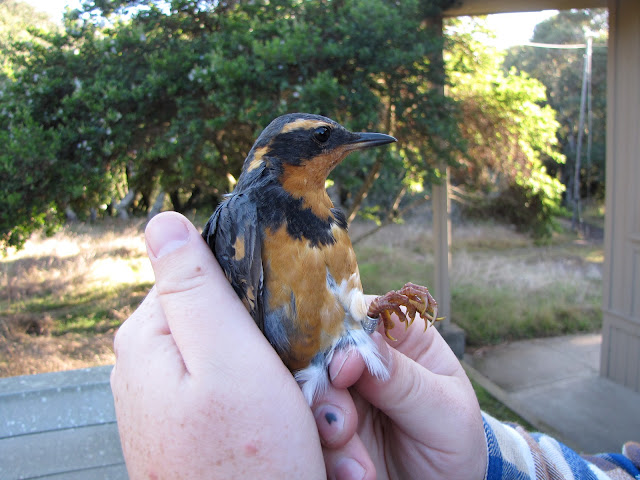A quick and dirty molt lesson that will focus on a few aspects of molt that are necessary to know if you want to understand how and why we age birds the way we do:
All birds (for our intents and purposes) undergo one main molt, or growing-in of new feathers, each year. This molt is called the prebasic molt in AHY (after hatch year) birds, and the preformative molt in HY (hatch year) birds. Molts can be complete, incomplete, or partial. During a complete molt, birds grow in all new feathers--this includes all body feathers, and all flight (wing and tail) feathers. Birds that undergo an incomplete molt will grow in new body feathers and some, but not all, flight feathers. Finally, during a partial molt, birds grow in new body feathers and a varying number of wing coverts, but generally no flight feathers.
Now, why is this important? It is important because almost every adult (AHY) bird will undergo a complete prebasic molt, but the HY birds that have a prefomative molt will usually have a partial or incomplete molt. And it is specifically this partial or incomplete molt that will allow us to see a molt limit!
Molt limits are the "boundaries between replaced and retained feathers, resulting from partial or incomplete molts" (Pyle 1997). These boundaries are visible because the newer, replaced, feathers are generally less worn and less faded than older, retained, feathers. So, if all (minus an exception or two) adult birds have complete prebasic molts, then a bird showing a molt limit must be a........................hatch year bird!
 |
| Bird Topography. |
We had a typical but interesting day at Palo today, with two Varied Thrush and a brand new hatching year female Spotted Towhee. Check out some photos and descriptions of how we age and sex these species.
 |
| HY male Varied Thrush. Females would generally not have such dark auriculars (cheek band) and breast band. [Photo by Cory Ritter] |
 |
| HY male Varied Thrush. Most of the rectrices (tail feathers) look fairly tapered rather than truncate, which is a good sign that this bird is a HY. HY birds of most species retain many of their juvenal flight feathers. These feathers are grown in the nest and quickly, so the quality is much lower than those of adults. [Photo by Cory Ritter] |
 |
| HY Varied Thrush. Note the overall ratty appearance and brown wash to the head and back (brown on the back is hard to see in the photo). The wear and overall messiness is not a definitive indicator of age, but it certainly is supportive of a first year bird. Again, this is because juvenal flight feathers are grown rapidly, and so are of poor quality, and become worn quickly in the nest. [Photo by Cory Ritter] |
 |
| Male Varied Thrush. Deeper orange and blacker black than the previous HY above. [Photo by Luke Musher] |
 |
| Male Varied Thrush. Note neater, better quality flight feathers, broad and rather truncate primary coverts, indicative of an after hatching-year bird. [Photo by Luke Musher] |
 |
| These rectrices appear more tapered than those of the previous Varied Thrush. The inner edges of the outer rectrices form a gradual curve. After-hatch-year birds will show rectrices whose inner edges form abrupt angles. This ambiguity kept us from aging the bird. [Photo by Luke Musher] |
 |
| HY female Spotted Towhee. Its brownish rather than blackish head, wings and back indicate that it's a female. |
 |
| HY female Spotted Towhee. This Is textbook HY rectrix shape, narrow and tapered. [Photo by Dan Lipp] |
 |
| Can you find the molt limit in this photo? [Photo by Dan Lipp] |
 |
| Okay okay, not the best photo, but enlarging the photo, and putting in a nice red arrow, should help you spot the molt limit. The replaced alula covert on top is darker (less faded) than the retained alula feather. This is another clue that the towhee is a HY. [Photo by Dan Lipp] |
By Cory Ritter, Luke Musher, and Dan Lipp












No comments:
Post a Comment